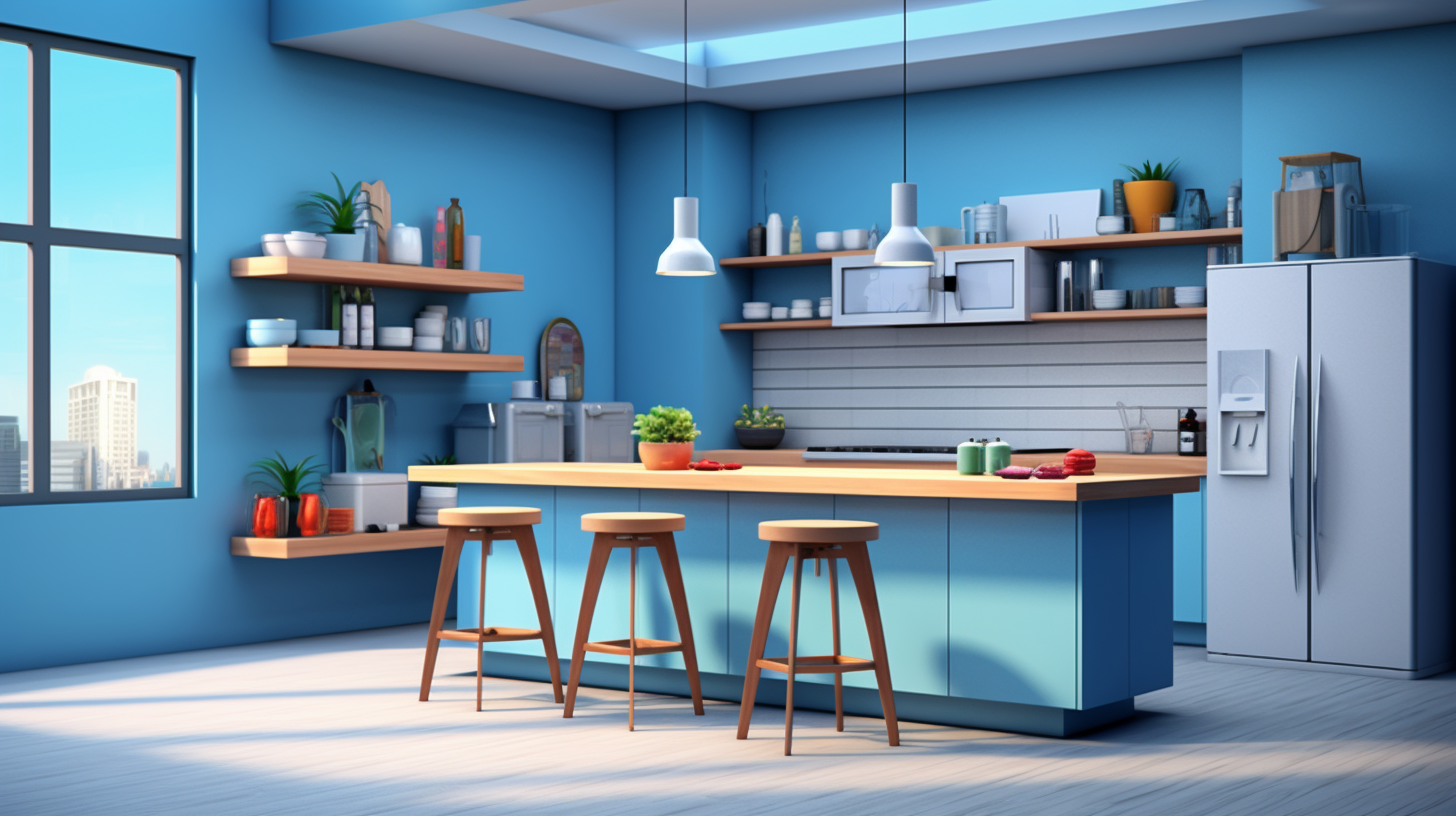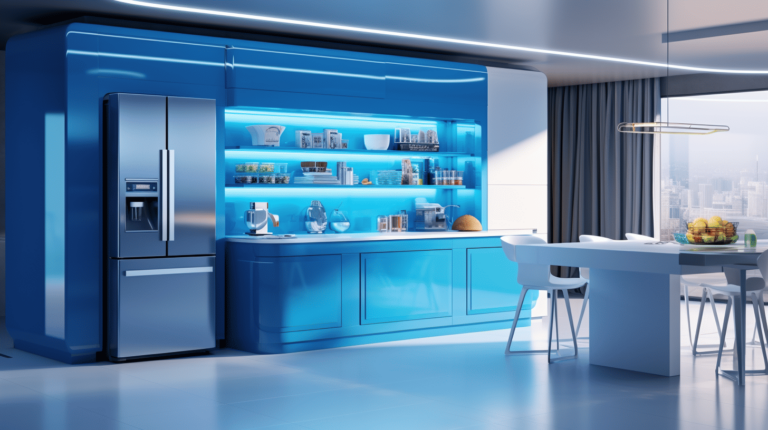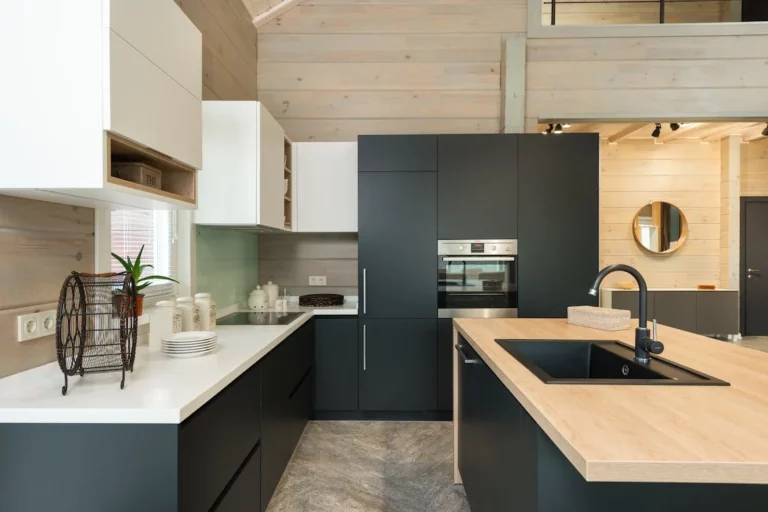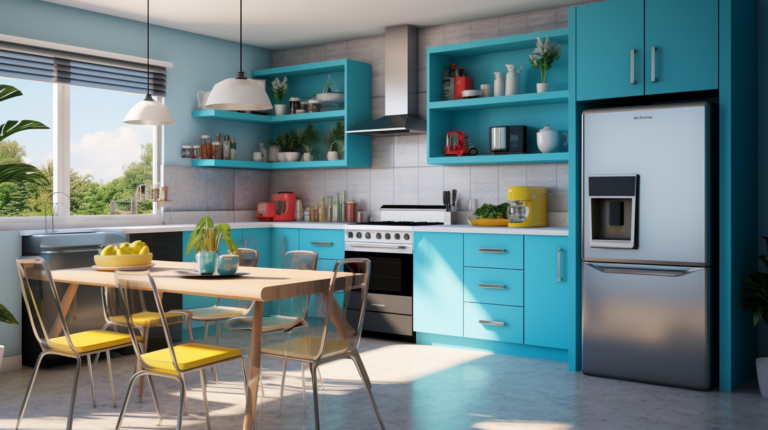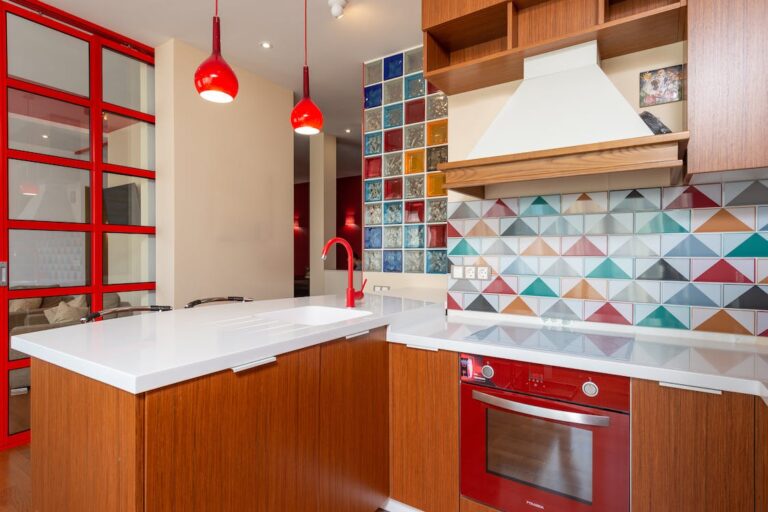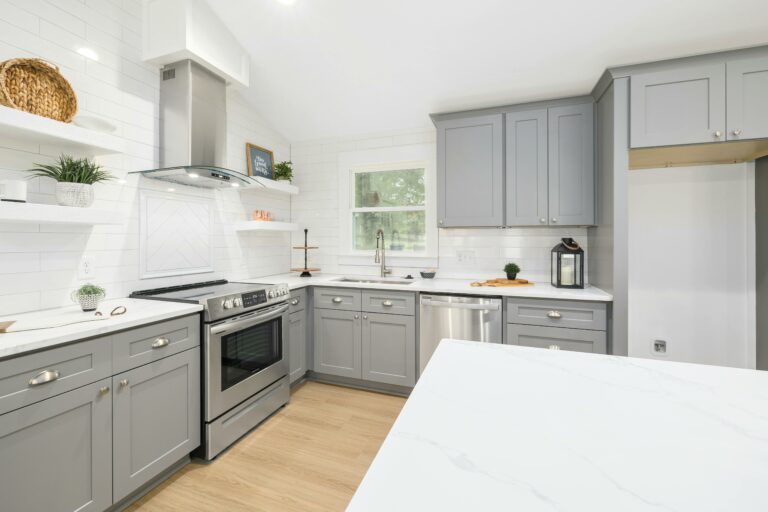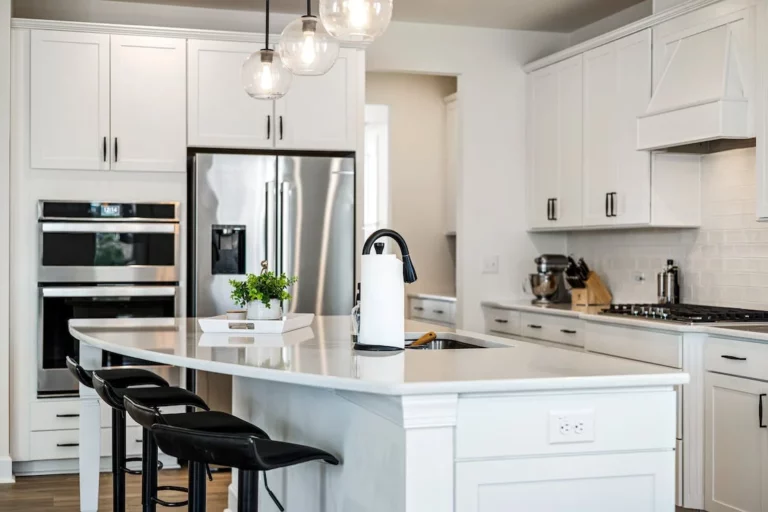Transform Your Kitchen with a Fresh Coat of Paint: Color Ideas and Tips in 2023
Welcome to our guide to transform your kitchen with a fresh coat of paint! If you’re looking to give your kitchen a refreshing makeover without breaking the bank, painting is an excellent choice. Not only is it cost-effective, but it also allows you to completely change the look and feel of your kitchen in just a few simple steps.
Whether you’re tired of outdated colors, want to add some personality, or simply need a change, painting your kitchen is a great way to achieve a stunning transformation. In this guide, we’ll walk you through everything you need to know about choosing the right colors, preparing for painting, essential tools and materials, painting techniques, color ideas, accent walls, finishing touches, and maintaining your newly painted surfaces.
By the end of this guide, you’ll be armed with the knowledge and inspiration to tackle your kitchen painting project with confidence. So let’s dive in and discover the wonderful world of kitchen style painting!
Table of Contents
- 1 Choosing the Right Color Palette
- 2 Preparation for Painting
- 3 Essential Painting Tools and Materials
- 4 Painting Techniques for a Professional Finish
- 5 Color Ideas to Transform Your Kitchen
- 6 Accent Walls and Creative Designs
- 7 Finishing Touches and Decorative Elements
- 8 Maintaining and Caring for Painted Surfaces
- 9 Conclusion
- 10 Frequently Asked Questions
Choosing the Right Color Palette

Choosing the right color palette is crucial when transforming your kitchen style with a fresh coat of paint. The colors you choose will set the tone and ambiance of your kitchen, so it’s important to consider a few factors before making a decision. Here are some tips to help you choose the perfect color palette for your kitchen:
Consider the Kitchen Style and Ambiance
- Take into account the style of your kitchen. Is it modern, traditional, or farmhouse? The color palette should complement the overall your kitchen style.
- Think about the ambiance you want to create in your kitchen. Do you want it to feel cozy and warm, or bright and airy? The colors you choose can greatly impact the mood of the space.
Evaluate Natural Light and Room Size
- Consider the amount of natural light your kitchen receives. If it’s a well-lit space, you have more freedom to choose darker colors. However, if your kitchen lacks natural light, lighter colors can help brighten up the space.
- Take into account the size of your kitchen. Lighter colors can make a small kitchen appear larger, while darker colors can make a large kitchen feel cozier.
Popular Kitchen Color Trends
- Neutrals: Neutral colors like white, beige, and gray are timeless and versatile. They create a clean and classic look that works well with any kitchen style.
- Blues and Greens: These colors evoke a sense of calmness and bring a touch of nature into your kitchen. From soft pastel blues to bold emerald greens, there are various shades to choose from.
- Bold and Vibrant: If you want to make a statement in your kitchen, consider using bold and vibrant colors like red, orange, or yellow. These colors can add energy and personality to your space.
- Earth Tones: Colors like brown, tan, and terracotta create a warm and inviting atmosphere in your kitchen. They can complement rustic or earthy kitchen styles.
The right color palette can transform your kitchen into a space that reflects your personal style and enhances the overall aesthetic of your home. Consider your kitchen style, the ambiance you want to create, and popular color trends to choose the perfect colors for your kitchen transformation.
Preparation for Painting

Before you can transform your kitchen style with a fresh coat of paint, it’s important to properly prepare the space to ensure the best results. Taking the time to prepare properly will make a significant difference in the final outcome of your painting project. Here are some essential steps to follow when preparing your kitchen for painting:
Cleaning and Clearing the Kitchen
- Start by thoroughly cleaning all surfaces in your kitchen. Grease and grime can build up over time, and it’s important to remove any dirt or residue before painting.
- Remove any items from the countertops, shelves, and cabinets. This will make it easier to access the walls and ensure that no paint splatters onto your belongings.
Repairing Damaged Surfaces
- Inspect the walls for any cracks, holes, or other damages.
- Use spackling compound to fill in any holes or cracks. Allow the compound to dry completely and then sand it smooth.
- If there are any areas of peeling paint, scrape off the loose paint and sand the surface to create a smooth and even base for painting.
Priming the Walls
- Applying a primer is an essential step in the painting process, especially if you’re changing the color of your kitchen walls significantly. Primer creates a neutral base for the new paint color and helps it adhere better.
- Choose a high-quality primer that is suitable for your kitchen walls. Apply the primer evenly using a paint roller or brush.
- Allow the primer to dry completely before moving on to the next step. This usually takes around 24 hours, but it’s best to check the manufacturer’s instructions for specific drying times.
By following these preparation steps, you’ll ensure that your kitchen walls are in the best possible condition for painting. Taking the time to clean, repair, and prime will help you achieve a professional finish and make your newly painted kitchen look its best.
Essential Painting Tools and Materials
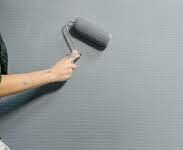
When it comes to transforming your kitchen style with a fresh coat of paint, having the right tools and materials is essential. Here are some painting tools and materials you’ll need to ensure a successful and professional-looking paint job:
- Paint Brushes and Rollers: Selecting the right paint brushes and rollers can make a big difference in the final result of your paint job. Here are some tips to keep in mind:
- Choose high-quality brushes and rollers to ensure smooth and even paint application.
- Synthetic brushes are ideal for latex-based paints, while natural bristle brushes work well with oil-based paints.
- Consider the size of the brush or roller based on the area you’ll be painting.
- Painter’s Tape and Drop Cloths: These are essential for protecting areas that you don’t want to get paint on. Use painter’s tape to cover edges, trim, and other surfaces that should remain paint-free. Drop cloths will protect your floors and countertops from splatters and spills.
- Paint Trays and Stir Sticks: Paint trays provide a convenient container for holding small amounts of paint while you work. It makes it easier to dip your brush or roller into the paint evenly. Stir sticks are necessary for thoroughly mixing the paint before applying it to the walls.
- Primer: Before applying the actual color, it’s important to prime your kitchen walls. Primer helps create an even surface for paint adhesion and ensures better coverage. Choose a primer specifically designed for the type of paint you’ll be using.
- Sanding Materials: If you have any rough or uneven surfaces on your walls, sanding them down before painting is crucial. Use sandpaper or a sanding block to smooth out any imperfections and create a clean canvas for painting.
- Putty Knife: If there are any holes or cracks in your walls, use a putty knife and spackling compound to fill them in. Smooth out the excess filler and allow it to dry before sanding.
- Paint Roller Extension Pole: This handy tool allows you to reach high or hard-to-reach areas without having to use a ladder. It’s particularly useful when painting kitchen cabinets or around light fixtures.
- Paint Tray Liners and Disposable Gloves: To make cleanup easier, use disposable paint tray liners. They prevent the tray from getting messy and can be easily discarded when you’re finished. Disposable gloves will protect your hands from paint and make cleanup a breeze.
Having these essential painting tools and materials on hand will ensure that your kitchen style painting project goes smoothly and efficiently. Make sure to choose high-quality products for the best results. So, gather your tools and get ready to transform your kitchen with a fresh coat of paint!
Painting Techniques for a Professional Finish

When it comes to transforming your kitchen style with a fresh coat of paint, using the right painting techniques can make all the difference in achieving a professional finish. Here are some tips and tricks to help you achieve that flawless look:
Applying the Base Coat
Applying a smooth and even base coat is essential for a professional finish. Here are some steps to follow:
- Preparation: Start by cleaning the walls and making sure they are free from any dust or grease. Sand any rough patches and repair any holes or cracks in the surface.
- Priming: Before applying the base coat, it’s important to apply a primer. This will create a smooth and uniform surface for the paint to adhere to. Use a roller or a brush to apply the primer, making sure to cover the entire surface evenly.
- Paint Application: Once the primer is dry, it’s time to apply the base coat of paint. Use a roller for larger areas and a brush for smaller, more intricate areas. Start from the top and work your way down, applying the paint in smooth, even strokes. Be sure to overlap the edges of each stroke to avoid visible brush marks.
Creating Texture with Faux Finishes
If you want to add some texture to your kitchen walls, consider using faux finishes. Faux finishes can mimic the look of materials like plaster, stone, or wood, giving your kitchen a unique and sophisticated look. Here are a few popular faux finish techniques:
- Sponging: This technique involves lightly dabbing a sponge dipped in paint onto the walls. It creates a mottled, textured effect that adds depth and interest to the surface.
- Dragging: Dragging involves dragging a dry brush or a rag through wet paint to create long, subtle lines. This technique can be used to create a subtle striped or marbled effect on the walls.
- Stippling: Stippling is done by lightly tapping a stippling brush or a sponge onto the walls. It creates a textured, speckled effect that can resemble the texture of stucco or plaster.
Utilizing Stencils or Patterns
If you’re looking to add some visual interest to your kitchen walls, consider using stencils or patterns. Stenciling is a great way to add intricate designs or geometric patterns to your walls. Here are a few tips to keep in mind when using stencils:
- Choosing the Right Stencil: Select a stencil that complements your kitchen style and color scheme. There are a wide variety of stencils available, ranging from floral motifs to geometric patterns.
- Preparing the Surface: Make sure the surface is clean and dry before applying the stencil. Use painter’s tape to secure the stencil in place and prevent it from shifting while you paint.
- Applying the Paint: Use a small brush or a stencil brush to apply the paint. Start from the edges of the stencil and work your way towards the center, using light, dabbing motions to prevent the paint from bleeding under the stencil.
Utilizing painting techniques like these can help you achieve a professional finish and turn your kitchen into a stunning space. Get creative, experiment with different techniques, and have fun transforming your kitchen style with a fresh coat of paint!
Color Ideas to Transform Your Kitchen

Are you looking to transform your kitchen style with a fresh coat of paint? Updating the color of your kitchen walls is a cost-effective way to give your space a whole new look and feel. Whether you want to create a cozy and warm ambiance or a bright and energetic atmosphere, choosing the right color palette is key. In this section, we will explore some color ideas for your kitchen style transformation. Let’s dive in!
Neutral Tones for a Timeless Look
Neutral colors are always a great choice for kitchen styles, as they provide a timeless and sophisticated look. Here are a few ideas to consider:
- White: Crisp and clean, white walls can make your kitchen feel larger and brighter. It also provides a blank canvas for other elements in the room, such as colorful accessories or artwork.
- Beige: Beige is a warm and inviting neutral color that can create a cozy and welcoming atmosphere in your kitchen. It pairs well with a variety of cabinet colors and countertop materials.
- Gray: Gray has become increasingly popular in kitchen design, thanks to its versatility and modern appeal. Light gray tones can create a sleek and contemporary look, while darker grays add depth and sophistication.
Bold and Vibrant Colors for Personality
If you want to add personality and a pop of color to your kitchen, consider these bold and vibrant options:
- Blue: Blue is a soothing and calming color that can create a serene atmosphere in your kitchen. Light blues, such as aqua or sky blue, are perfect for coastal or farmhouse style kitchens, while deeper blues create a more dramatic effect.
- Green: Green is a refreshing and nature-inspired color that works well in kitchens. From subtle sage greens to vibrant lime or emerald green, this color can breathe life into your space.
- Yellow: Yellow is known for its cheerful and uplifting qualities. It can bring warmth and energy to your kitchen, making it a great choice for a lively and inviting ambiance.
Light and Pastel Shades for an Airy Feel
For those who prefer a light and airy feel in their kitchen, pastel shades can be a wonderful option. Consider these soft and delicate colors:
- Pale Pink: Pale pink adds a touch of femininity and elegance to your kitchen. It pairs well with white or light gray cabinets for a sophisticated look.
- Mint Green: Mint green is a refreshing and tranquil color that creates a sense of serenity in your kitchen. It works well with white or wood cabinets, creating a fresh and inviting space.
- Lavender: Lavender is a calming and soothing color that can bring a sense of tranquility to your kitchen. Pair it with white or light gray cabinets for a soft and dreamy look.
Remember, when choosing a color for your kitchen style, consider the overall style of your home, the amount of natural light in the space, and the size of the room. Don’t be afraid to take risks and experiment with different color combinations to create a kitchen style that truly reflects your personality and style.
“I love how a fresh coat of paint can completely transform a kitchen style. Choosing the right color palette is so important, and I hope these ideas inspire you to create a kitchen that you love.”
Accent Walls and Creative Designs

When it comes to transforming your kitchen style with a fresh coat of paint, one way to add a pop of personality and style is by incorporating accent walls and creative designs. Accent walls can create a focal point in the room and make a bold statement, while creative designs can add depth and visual interest to your kitchen space.
Choosing the Perfect Accent Wall
Choosing the right wall for your accent can make a big difference in the overall aesthetic of your kitchen style. Here are a few considerations to keep in mind:
- Choose a wall that stands out: Look for a wall that naturally draws attention, such as the one behind the stove or sink, or the one opposite the entrance to the kitchen.
- Consider the color scheme: Select a color that contrasts nicely with the rest of the kitchen. For example, if you have a predominantly light-colored kitchen, a dark accent wall can create a striking contrast.
- Highlight architectural features: If your kitchen has unique architectural features, such as a brick wall or a built-in shelf, consider using it as an accent wall to highlight its beauty.
Incorporating Stripes, Patterns, and Murals
If you want to take your accent wall to the next level, consider incorporating stripes, patterns, or even a mural to create a dramatic effect. Here’s how you can achieve this:
- Stripes: Painting stripes on your accent wall can add a touch of playfulness and create visual interest. You can use painter’s tape to create evenly spaced stripes, or experiment with varying widths for a more eclectic look.
- Patterns: From chevron to herringbone, there are endless possibilities for creating unique patterns on your accent wall. You can either use stencils or create your own pattern using painter’s tape.
- Murals: If you’re feeling particularly artistic, why not paint a mural on your accent wall? Whether it’s a scenic landscape or a whimsical design, a mural can truly transform your kitchen into a work of art.
Adding a Chalkboard or Magnetic Wall
Looking for a creative and functional design idea? Consider adding a chalkboard or magnetic wall to your kitchen. Here’s how they can elevate your space:
- Chalkboard wall: Painting one of your kitchen walls with chalkboard paint can instantly add a touch of fun and functionality. Use it as a place to jot down your grocery list, write recipes, or leave notes for your family.
- Magnetic wall: If you prefer a sleeker look, a magnetic wall may be the way to go. Magnetic paint can transform any wall into a magnetic surface, allowing you to hang up recipes, notes, and even kitchen utensils using magnets.
By incorporating accent walls and creative designs into your kitchen, you can truly transform the look and feel of the space. Whether it’s a bold color choice, unique patterns, or functional features like a chalkboard or magnetic wall, these design elements will add personality to your kitchen style.
Now that you have some ideas for creating accent walls and creative designs, it’s time to move on to the next step – adding those finishing touches and decorative elements that will truly complete your kitchen transformation.
Finishing Touches and Decorative Elements
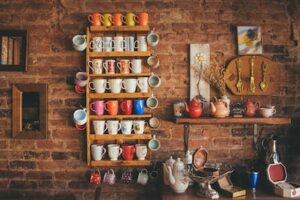
Once you’ve completed painting your kitchen walls, it’s time to add the finishing touches and decorative elements that will bring the space to life. These final touches can make a big difference in the overall look and feel of your kitchen style. Here are some ideas to consider:
Selecting Complementary Cabinet Colors
- Coordinate with the Wall Color: Choose cabinet colors that complement the color of your walls. If you have lighter walls, consider darker cabinet colors for a striking contrast, and vice versa.
- Adding a Pop of Color: If you prefer a bold and vibrant look, consider choosing a cabinet color that contrasts with the wall color. For example, if you have neutral walls, a bright red or blue cabinet can add a pop of color and make a statement.
Updating Hardware and Fixtures
- Replacing Cabinet Handles and Knobs: Swapping out old cabinet handles and knobs with new ones can instantly refresh the look of your kitchen. Choose hardware that complements the style and color of your cabinets.
- Updating Faucets and Lighting Fixtures: Consider updating your faucets and lighting fixtures to match the new color scheme of your kitchen. This can give your space a cohesive and polished look.
Enhancing with Wall Art and Accessories
- Choosing Artwork: Select artwork that complements the colors and style of your kitchen. Look for pieces that incorporate the main color of your walls or cabinet to tie the room together.
- Displaying Decorative Items: Use decorative items such as vases, bowls, or plants to add visual interest to your kitchen. These items can bring personality and charm into the space.
- Displaying Cookware and Utensils: If you have beautiful cookware or utensils, consider hanging them on a wall or displaying them on open shelves. This can add a functional and decorative element to your kitchen.
Remember, when adding finishing touches and decorative elements to your kitchen, keep in mind the overall style and ambiance you want to achieve. Choose items that fit seamlessly into the color scheme and enhance the overall aesthetic of the space.
“The finishing touches are what truly complete the look of a painted kitchen. Pay attention to the details and select items that complement your color palette for a cohesive and polished space.”
Maintaining and Caring for Painted Surfaces
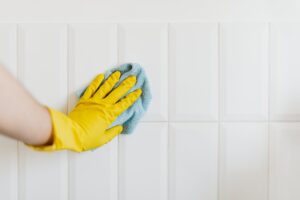
Once you’ve transformed your kitchen style with a fresh coat of paint, it’s important to know how to maintain and care for those beautifully painted surfaces. Proper maintenance will ensure that your paint job lasts for years to come. Here are some tips on how to keep your painted surfaces looking their best:
Cleaning and Wiping Down Walls
- Regularly clean your painted walls to remove dust, dirt, and grease buildup. Start by dusting the walls with a soft cloth or feather duster to remove any loose particles.
- Use a mild detergent and warm water solution to clean the walls. Avoid using harsh chemicals or abrasive cleaners, as they can damage the paint.
- Gently scrub the walls using a sponge or soft cloth. Start from the top and work your way down to avoid streaking or dripping.
- Rinse the walls with clean water and pat them dry with a clean cloth or towel. Make sure to thoroughly dry the walls to prevent any water spots or streaks.
Touching Up Paint as Needed
- Over time, painted surfaces can suffer from small nicks, scratches, or chips. To keep your kitchen looking fresh, it’s important to touch up these areas as soon as you notice them.
- Start by lightly sanding the area with fine-grit sandpaper to smooth out any rough edges. Wipe away any dust or debris with a clean cloth.
- Use a small brush or a small foam roller to carefully apply a thin coat of matching paint to the damaged area. Feather the edges of the new paint into the surrounding surface for a seamless finish.
- Allow the touch-up paint to dry completely before assessing if another coat is needed. It’s better to apply multiple thin coats than one thick coat.
- If you no longer have the original paint color, take a sample of the existing paint to a paint store and have them color-match it for you.
Protecting Walls from Moisture and Stains
Kitchens are prone to moisture and splatters, which can stain or damage painted surfaces. To protect your walls from these potential issues:
- Install a backsplash behind your sink and stove area to protect the walls from water and oil splatters.
- Use a good-quality paint with a semi-gloss or satin finish, as they are more resistant to moisture and can be easily wiped clean.
- Consider applying a clear topcoat or sealer over the paint to provide an extra layer of protection against stains and moisture. Consult with a professional to determine the best product for your specific needs.
By following these maintenance tips, your painted kitchen walls will continue to look fresh and beautiful for years to come. Remember to clean regularly, touch up any imperfections, and protect your walls from moisture and stains. With proper care, your newly painted kitchen will remain a stunning focal point in your home.
Also read; The Perfect Blend: Balancing Function and Aesthetics in Your Home Design in 2023
Conclusion
In conclusion, transforming your kitchen style with a fresh coat of paint can be a game-changer for your home. It not only enhances the overall aesthetic but also allows you to personalize your space and create a welcoming atmosphere. By choosing the right color palette, carefully preparing for painting, utilizing essential tools and materials, and implementing painting techniques, you can achieve a professional finish.
Consider the various color ideas for your kitchen style transformation, such as neutral tones for a timeless look, bold and vibrant colors for personality, or light and pastel shades for an airy feel. Don’t be afraid to get creative with accent walls and incorporate stripes, patterns, or even murals. Remember to pay attention to the finishing touches and decorative elements, including complementary cabinet colors, updated hardware and fixtures, and wall art and accessories that enhance the overall design.
Once your kitchen is freshly painted and looking fabulous, it’s important to maintain and care for the painted surfaces. Regular cleaning and wiping down walls, touching up paint as needed, and protecting them from moisture and stains will ensure the longevity and durability of your new paint job.
So, why wait? Take the leap and transform your kitchen today with a fresh coat of paint. Get ready to enjoy an updated, stylish, and inviting space that reflects your personal taste and brings joy to your everyday life. Happy painting!
Frequently Asked Questions
- What are some popular kitchen paint colors?Some popular kitchen paint colors include white, gray, navy blue, sage green, and warm neutral tones like beige or tan.
- Should I use a glossy or matte finish for kitchen paint?For kitchen paint, it is recommended to use a semi-gloss or satin finish. These finishes are more durable and easier to clean, making them ideal for high-moisture areas like the kitchen.
- How do I choose the right color for my kitchen?When choosing a color for your kitchen, consider factors such as the size and layout of your kitchen, existing decor and cabinetry, natural lighting, and your personal style preferences. It’s also helpful to create a color palette or sample different shades before making a final decision.
- What are some tips for painting kitchen cabinets?Some tips for painting kitchen cabinets include proper cleaning and sanding of the cabinets, using a high-quality primer and paint, applying multiple thin coats for a smooth finish, and allowing ample drying time. It’s also important to label and organize cabinet hardware for easy reinstallation.
- How can I make a small kitchen appear larger with paint?To make a small kitchen appear larger with paint, opt for light or neutral colors, as they reflect more light and create a sense of openness. Avoid using dark or bold colors that may make the space feel cramped. Additionally, using a high-gloss finish on cabinets and walls can help enhance the illusion of space.

